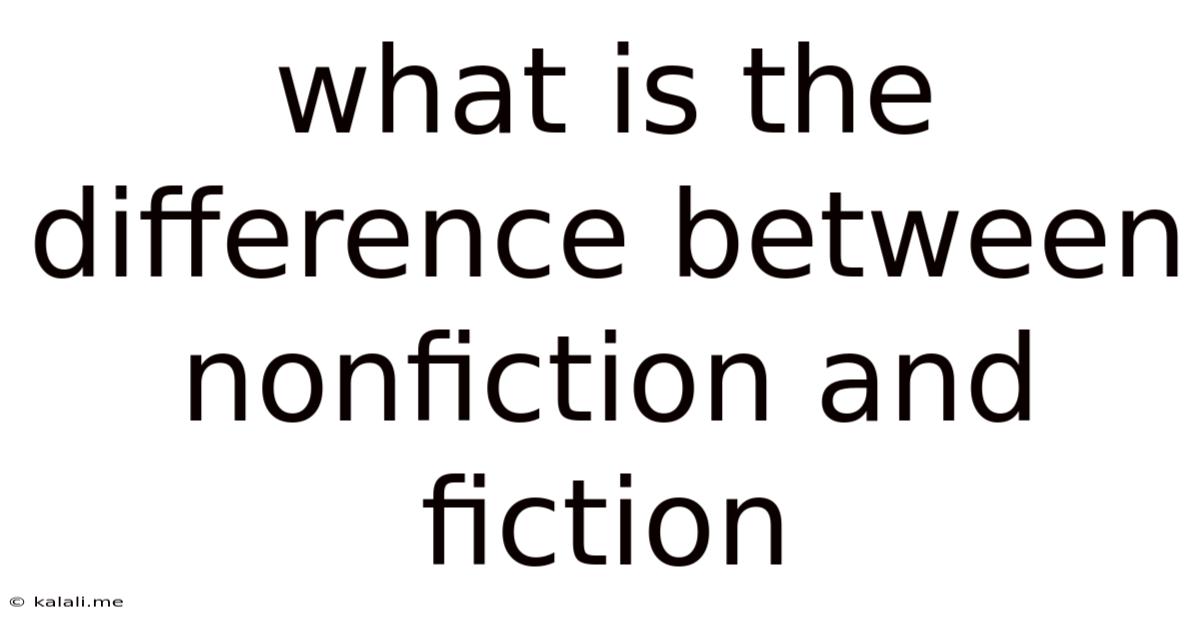What Is The Difference Between Nonfiction And Fiction
Kalali
Jun 13, 2025 · 3 min read

Table of Contents
Nonfiction vs. Fiction: Unveiling the Differences Between Fact and Fantasy
The world of literature is vast and varied, encompassing countless genres and styles. Two fundamental categories, however, stand out: nonfiction and fiction. While seemingly simple, the distinction between these two forms of writing holds significant weight, impacting how we interpret and engage with the narratives presented. This article will delve into the core differences between nonfiction and fiction, exploring their defining characteristics and highlighting key examples.
Understanding Nonfiction: The Realm of Reality
Nonfiction, at its core, focuses on factual information and real-world events. It aims to inform, educate, or persuade the reader based on verifiable truths. This doesn't mean it lacks creativity or engaging storytelling; rather, it utilizes these elements to present factual information in a compelling and accessible manner. Key characteristics of nonfiction include:
- Factual Accuracy: This is paramount. Statements and claims should be supported by evidence, research, and verifiable sources. Accuracy and truthfulness are cornerstones of the genre.
- Real-World Subjects: Nonfiction explores real people, places, events, and concepts. The focus is on documenting or analyzing aspects of the real world.
- Informative or Persuasive Intent: The primary purpose is typically to inform, explain, persuade, or analyze rather than to entertain through imagined scenarios.
- Diverse Forms: Nonfiction encompasses a wide range of formats, including biographies, autobiographies, essays, memoirs, documentaries, news reports, scientific papers, and historical accounts.
Examples of Nonfiction:
- "Sapiens: A Brief History of Humankind" by Yuval Noah Harari: A non-fiction exploration of human history.
- "The Autobiography of Malcolm X" by Malcolm X: A powerful personal account of a significant figure.
- "Silent Spring" by Rachel Carson: A seminal work of environmental journalism.
Exploring Fiction: The World of Imagination
Fiction, on the other hand, delves into the realm of imagination. It creates narratives based on invented characters, settings, and events, offering readers a glimpse into worlds that may exist only in the writer's mind. While it may draw inspiration from reality, the core of fiction is its departure from factual accuracy to explore themes, ideas, and human experience. Key aspects of fiction include:
- Imagined Worlds: The narratives are entirely or partially fabricated, existing solely within the realm of the author's imagination.
- Creative Storytelling: Emphasis is placed on creating compelling narratives, engaging characters, and exploring complex themes through creative storytelling techniques.
- Entertainment and Exploration: Fiction aims primarily to entertain, engage the reader emotionally, and explore the human condition through imagined scenarios.
- Varied Genres: Fiction encompasses an incredibly diverse range of genres, from fantasy and science fiction to romance, mystery, thriller, historical fiction, and literary fiction.
Examples of Fiction:
- "To Kill a Mockingbird" by Harper Lee: A classic work of literary fiction.
- "1984" by George Orwell: A dystopian novel exploring themes of totalitarianism.
- "Harry Potter and the Sorcerer's Stone" by J.K. Rowling: A groundbreaking work of fantasy fiction.
The Blurred Lines: Creative Nonfiction
While the distinction between nonfiction and fiction is generally clear, the line can sometimes blur, particularly with creative nonfiction. This genre blends factual accuracy with literary techniques often found in fiction, such as narrative structure, character development, and evocative language. Memoirs, for instance, often utilize literary devices while adhering to the factual basis of the author's personal experience.
In conclusion, while both nonfiction and fiction play vital roles in literature and storytelling, their fundamental difference lies in their relationship to reality. Nonfiction presents factual information, while fiction constructs imagined worlds. Understanding this distinction empowers readers to engage more critically and appreciate the unique strengths of each genre.
Latest Posts
Latest Posts
-
How Many Shots In A Half Gallon
Jul 01, 2025
-
Someone Once Told Me The World Was Macaroni
Jul 01, 2025
-
How Long Does It Take To Walk Five Miles
Jul 01, 2025
-
How Many Ounces Is A Pint Of Blueberries
Jul 01, 2025
-
How Many Dimes Are In 5 Dollars
Jul 01, 2025
Related Post
Thank you for visiting our website which covers about What Is The Difference Between Nonfiction And Fiction . We hope the information provided has been useful to you. Feel free to contact us if you have any questions or need further assistance. See you next time and don't miss to bookmark.